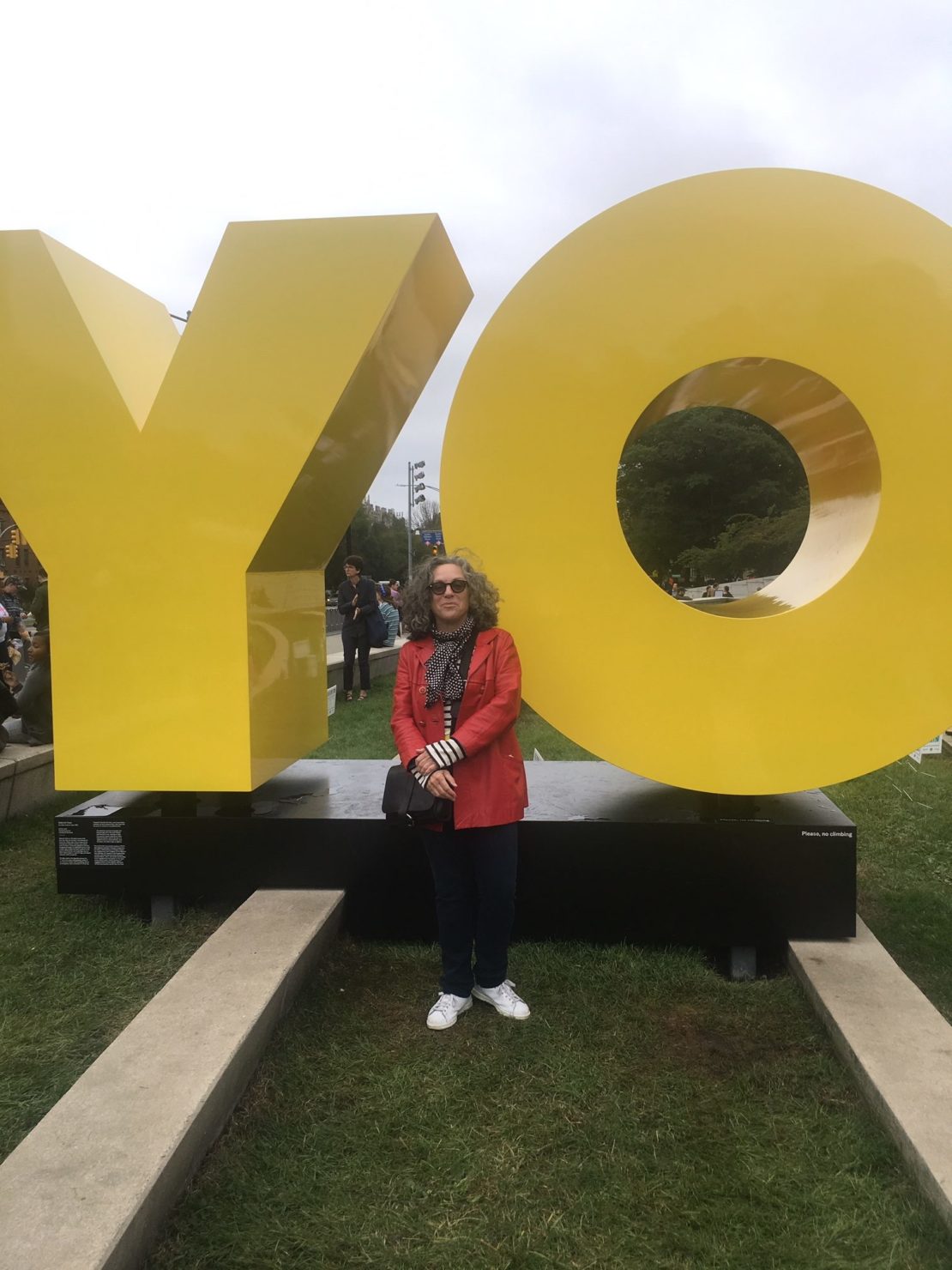Artist Deborah Kass’s monumental sculpture OY/YO was a phenomenon when it was first installed on Brooklyn Bridge Park’s Main Street lawn in 2015. Three years later, the groundbreaking work returns to Brooklyn, as part of a public art activation at the Brooklyn Museum. Joining text-based work by other Brooklyn-based artists—Brooklyn Hi-Art! Machine, Kameelah Janan Rasheed, and Hank Willis Thomas—OY/YO has been installed outside the Brooklyn Museum’s front entrance in a yearlong residency.
Kass’s large-scale work (measuring 8 x 17 x 5 ft) was conceived during Obama’s first term. About the making of the piece, Kass has said, “When I created OY/YO the American promise of equality and fairness was writ in the most diverse administration ever, working to make the country a better place for all. With hate and division now on the rise, it is urgent to see our commonalities, what we share, and what brings us together”.
I interviewed Deborah Kass on the steps of the Brooklyn Museum in October.
Danny Brody: I want to ask you a few things. I want to ask you about, of course, this installation. I want to ask you about Brooklyn, about New York, and about #Jewtude. I want to get to all of that, but first I want to ask you about your work in the past. I’m very intrigued by the way that you, I don’t want to say appropriate, but I just–
Deborah Kass: It’s the word.
DB: Okay, appropriate is the word?
DK: Yes. That’s the word.
DB: Male artist or other artist. What are you trying to accomplish through that work?
DK: Can you just give me a ballpark work you’re talking about?
DB: Well, like the Warhol stuff where you’re doing I don’t know if it’s an homage–
DK: That was both. It was both. An homage and a critique and it was 25 years ago. When I did that work it was about using a really familiar visual language and inserting myself into the discourse of post-war painting and into Warhol. I used Andy because he was so ubiquitous.
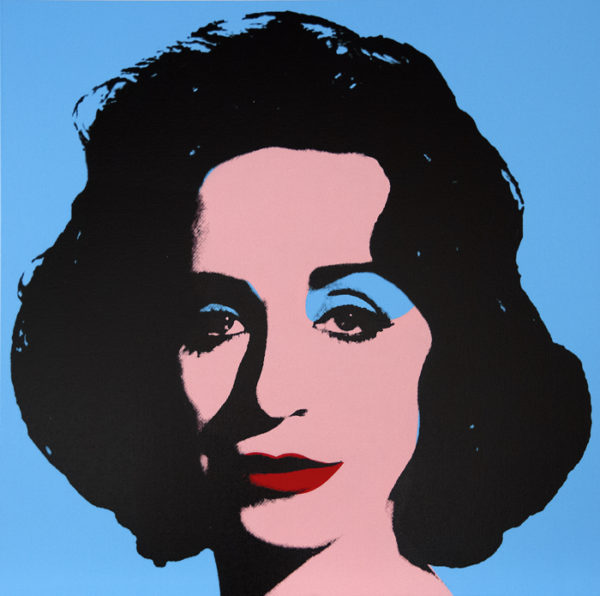
Blue Deb 2000, Deborah Kass, silkscreen and acrylic on canvas, 40 x 40 inches
DB: He is ubiquitous.
DK: He is. More now than then.
DB: Than ever. It’s kind of amazing. I remember the show that he did with Basquiat with the Boxing Gloves at Shafrazi’s gallery and it was a complete failure. I don’t know that when he died he was on a downhill slide, but he definitely–his stature grew exponentially.
DK: Yes. In ’92 when I started that project, he wasn’t what he is now. I mean he was Andy, don’t get me wrong, and I would say to many people the most important artist of his generation, including me. He wasn’t like the market monster he became but the market wasn’t the monster it’s become. His ubiquity now has to do with the licensing and–talk about appropriation, he’s been appropriated by popular culture now.
DB: It’s kind of appropriate since-
DK: It is appropriate.
DB: Since he was appropriating other objects for his work. Do you think that’s part of the work that you’ve done over your career? Perhaps it has to do with women artists taking over the dialogue?
DK: Yes. It’s about changing the narrative. Making it reflect us or me where we haven’t been reflected before. For me, it was using this common language people understood, which was Andy, to do that.
DB: Was there other work that you felt like where you were inserting yourself to sort of–
DK: Yes. The work I did before, and the work I’ve done since. Yes. Completely, specifically addresses the histories of post-war painting in particular, and uses various languages to insert my subject matter into it.
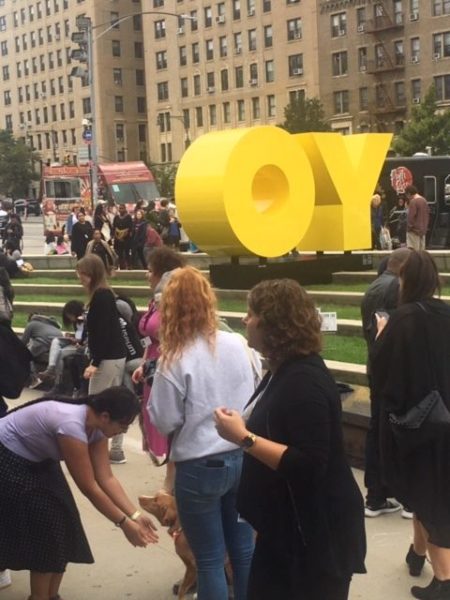
YO/OY Sculpture at Brooklyn Museum, Photo: Danny Brody
DB: Do you think this moment now where we’re having a real reckoning with how we treat women in society-people always think that something good is going to come of it and sometimes it doesn’t happen that way. Or it takes years or decades or centuries. Do you think something good is going to happen out of this, hopefully? How do you relate that also to the art world?
DK: It’s a great question. It’s really a long answer. I would say it’s my third round. I started my twenties with ’70s feminism, then we all had a big revival in the early ’90s with Women’s Action Coalition and the anti-abortion stuff with the Bush, H.W. Bush and Reagan and AIDS, the AIDS crisis, and here we are again. It’s a little depressing. I don’t understand why this is a fight. I thought we solved it in the ’70s. I really did. I was so surprised. This time I’m not surprised but boy is it depressing.
DB: It’s shocking in a way that we’re digressing, not digressing but I guess going back to these stages that we thought we wouldn’t have to go back to.
DK: You know, when there’s an assault on voting rights, to me it was clear this is where we were headed because that was 1964, 1965, the Civil Rights Act. To actually have black people disenfranchised systematically now, meant gay marriage was going to be under fire, women were going to be under fire and I’m just appalled. I’m just appalled. It’s not a great day for us. It’s is not a great day for anyone.
DB: Yes, the whole this Kavanaugh thing really brought a lot of very ugly stuff right to the top.
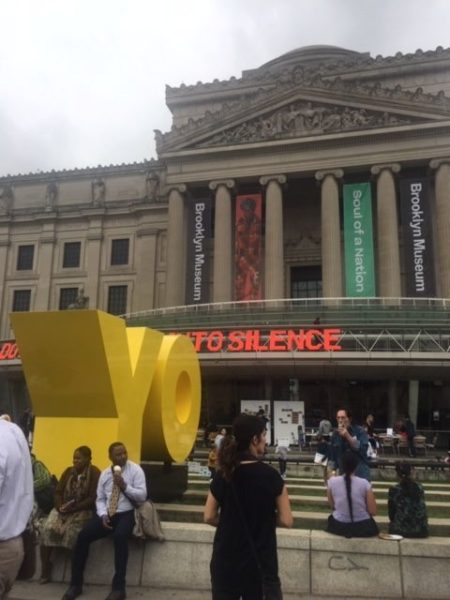
YO/OY Sculpture at Brooklyn Museum, Photo: Danny Brody
DK: It’s going to be really interesting. My niece is here at the museum, and my other niece is going to be here. They’re in their 20s, they grew up here and I’m terrified for them, but when you think about the level of outrage that we’ve been living with since November 8th, 2016, and every day is another outrage and really outrageous stuff. I’m completely worn down by it so I’m a wreck.
DB: I understand. I remember talking about Trump in the early days and people would say, “well, this is as bad as it’s going to get”, or “this the bottom”. I recall talking with my friends and we kept saying it’s going to get worse because we know this guy from living in New York and being from New York and when he senses blood, he just goes lower and lower and lower. If you just look at the Central Park Five issue, he’s still proclaiming that they’re guilty even after they were found innocent.
DK: No one voted for him here. 97% of us voted for Hillary because we know her.
DB: I vote in the South Bronx and I remember he won the Republican primary. I think it was already pretty much decided by then and he won the Bronx but it was like unanimous or something. It was like eight votes or something. I’m exaggerating but–
DK: It was 10.
DB: It could have been 10. You mentioned Brooklyn, let’s talk about Brooklyn and maybe let’s talk a little bit about the museum and your affinity for Brooklyn and why this installation is here.
DK: Can you give me a question?
DB: Yes.
DK: Can you pitch? I hit it.
DB: All right, all right, all right. Why is this installation, why is Brooklyn–
DK: It’s a sculpture. Let’s call it a sculpture. It’s just a work of art. That it’s a sculpture, that it is not a temporary object. It’s for real.
DB: This is really something big.
DK: I’m correcting people. Don’t call it an installation.
DB: No, that’s great. I was actually thinking about that on the walk from my car.
DK: It’s very much a sculpture and it’s very much about the history of sculptures. Again, post work sculptures, so it really means something to me that it’s just not a minimalism object.
DB: Let’s get back to Brooklyn.
DK: Brooklyn.

OY/YO installed in Dumbo, © 2018 Deborah Kass / Artists Rights Society (ARS), New York
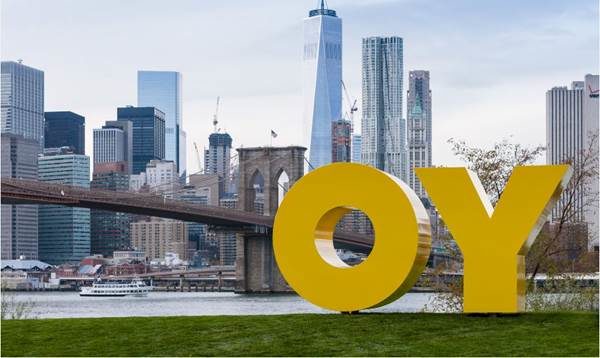
OY/YO installed in Dumbo, © 2018 Deborah Kass / Artists Rights Society (ARS), New York
DB: Brooklyn. Is there something about Brooklyn that if this sculpture has– Brooklyn and the sculpture have an affinity for each other?
DK: Well, I think that the way it’s been embraced from the first time it was–for the first time the sculpture was installed in Dumbo, it was an–
DB: Which was not an installation–
DK: Which is not an installation but it is installed, as sculptures are in places. It was just like an instant magnet for people which was wild because I didn’t ever think about that. Right here in Crown Heights or Prospect Heights, almost Crown Heights that it says “OY” on one side and “YO” on the other, talks to so many communities not just in Brooklyn. I mean, this would work very well in Miami, it would work very well in LA. It’s about communities and it’s about multiple communities.
DB: How are people reacting to the sculpture? You said that it was an outpouring of love for sculpture. Do you think that part of that is because we are such a mixed culture here and maybe it would be less embraced perhaps in a more homogeneous society?
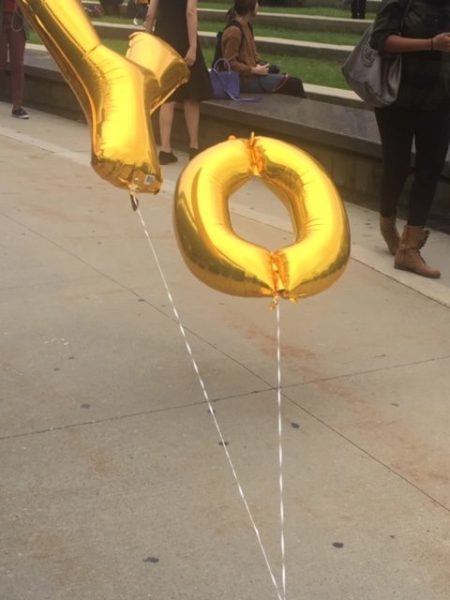
Brooklyn Museum, Photo: Danny Brody
DK: This is our society. This is America and this is New York but again I think particularly with what’s going on with immigration, it has a whole another resonance now because the Spanish were a lot so it’s not just, “Yo, Adrian” or yo, yo, yo or street or working class Italian guys or Jewish people saying, “Oy.” It’s Latino and it always was because- Spanish was my second language in high school- because this, “Yo,” it’s like, there’s a really famous painting “Yo, Picasso”, and it’s really important to me. In any urban center in America this would be pertinent because we’re all the same mix. We’re working-class Whites. We’re Black people. We’re Latino people. We’re Jewish people, and we live together in these cities. It’s what makes New York so right, and Brooklyn, so great.
DB: So great. I’m from here, but I left for a long time, and I came back about seven years ago. I noticed at that time or shortly thereafter, everybody was penning one of those Joan Didion, “Goodbye to All That” essays. See you around New York, I’ve had enough of you. It’s too homogeneous, too expensive-
DK: Yes. Well, that’s all true.
DB: Do you live here now?
DK: Yes.
DB: Do you see yourself ever saying goodbye to all that as far as that goes?
DK: I would like to say goodbye to the country, but I don’t know where to go. I can’t imagine where to go. We just came back from London, everyone is totally freaked out about Brexit. It’s the same situation. I mean, it’s not the same. Don’t say that. That’s incorrect. It’s their situation that’s a mess. The question was always like, where to go, but no, because I’m from here.
DB: Okay.
DK: My sister’s house– apartment’s like, 9th floor looking right down on where we are sitting.
DB: That’s pretty cool. When I was driving here– Just about me for a second. I live in the South Bronx. There’s not much going on there.
DK: Where are you?
DB: I’m by Melrose.
DK: What’s the street number?
DB: 164th.
DK: My grandmother had a store on a 170th.
DB: Okay. I had a lot of relatives who moved there and I guess-
DK: My mother’s whole– My mother-
DB: Whole family?
DK: Queens and Bronx. That’s my whole family.
DB: It’s just funny because people keep saying the South Bronx is like the new Brooklyn and all this, and I just really hate when they do that. Why can’t a neighborhood have its own identity? You wouldn’t say this neighborhood is the new something else, so let’s have our own identity. I don’t get that.
DK: It’s just a real estate marketing ploy. That’s all it is. You know them. It’s just real estate.
DB: Sometimes you find people actually saying it like they mean it. Not even thinking about how cynical it is.
DK: It is really sad. It is different. I lived in Tribeca my entire adult life till I moved to Brooklyn. Yes, it is homogenized. Then you get over here and it’s a little less homogenized. I just came from London. It’s the future of cities. I don’t know what we can do about it.
DB: Let’s move on to a happier topic. Seriously, the last thing I wanted to ask you is about the Jewish thing that’s #Jewtude. What is it about Jews and Jewishness that you find intriguing or what is the dynamic behind that that you find intriguing?
DK: I think that’s a weird question.
DB: Why is it weird?
DK: Because it’s like what’s intriguing about what you are. It’s like intriguing–
DB: Perhaps intriguing isn’t-
DK: That’s not the word.
DB: No, it’s not. What do you find so– What would the word be? Fulfilling?
DK: No, that’s not the word. What’s the word?
DB: Okay. What would the word be?
DK: Interesting?
DB: Interesting, worth talking about–
DK: Well, I think what you really mean is, how does representation of Jewishness work with representation of other identities? I think that’s what you mean.
DB: That was a great question that you asked of yourself.
DK: That I reinterpreted for you? [chuckles]
DB: Yes.
[laughter]DK: I knew what you meant.
DB: Yes.
DK: Let me help you.
DB: Yes. Thanks. It’s good when you do both parts.
DK: The question is representation of Jewish identity because it’s so infrequent. In the worlds of identity and issues of representation, it’s just something that I’ve been thinking about for 25 years. It’s not all of my work but my work definitely addresses it because why wouldn’t it?
DB: Well, I guess that says it all right there. Really, really loved doing this. Thanks for your help. Helping me out. Can I just take a picture of you in front of the sculpture?
DK: Sure. The sculpture.
DB: Sculpture. [laughter]
DK: Not to be confused with the installation.
DB: It just seemed like installation- I get what it is but it just seems like it’s another way of saying, “I wasn’t really sure where to put this so now, where it is, is sort of the heart of the sculpture.”
DK: What do you mean?
DB: Like, if it’s here, it’s an installation because it’s site-specific but if you move it somewhere else, then it’ll just be a sculpture.
DK: But it’s been to other places.
DB: Right, so, was it an installation there and here it’s a sculpture?
DK: No, it’s a sculpture.
DB: A sculpture that flies around?
DK: Is Robert Indiana’s “LOVE” a sculpture or an installation?
DB: Sculpture. Yes.
DK: There you go. That’s all you need to know. That’s it. No different.
DB: Okay. Fair enough. That was easy.
DK: That’s a sculpture, this is a sculpture.
DB: Okay. I’ll make it quick.
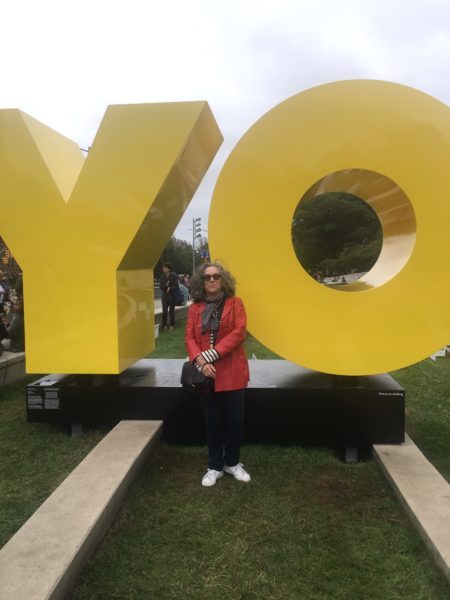
Deborah Kass, OY/YO, Photo: Danny Brody
OY/YO is on view at the Brooklyn Museum through Summer 2019.
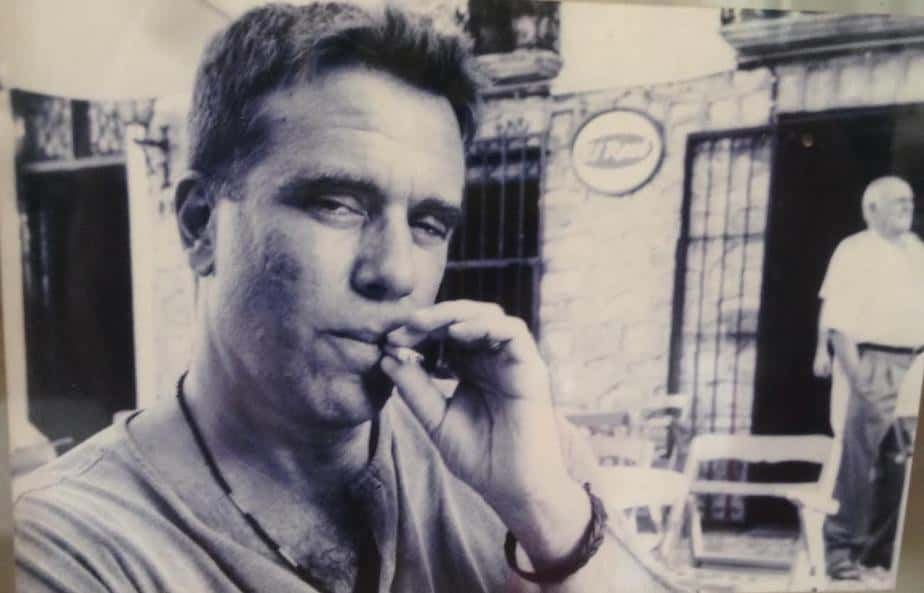
Danny Brody is the author of The Cold Shake (2018), a noir novel of ‘70’s New York, and The Gilded Palace of Sin (2008), a collection of poems. He created the seminal Miami food blog, Daily Cocaine, penned numerous food, wine, and booze columns for the Miami Herald, and wrote The Art of Hunger column for MAP Magazine. He has also written art, design, and architecture pieces for Modern Luxury Magazine, Design District Magazine, Social Affairs, and Art New Orleans. He lives in the South Bronx.

